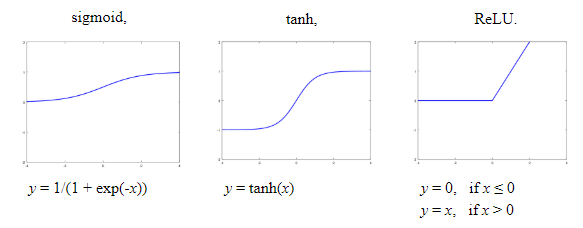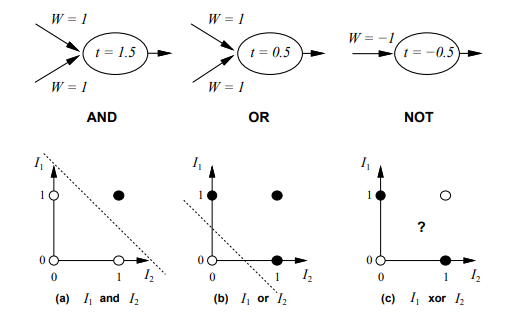Perceptrons
Perceptrons
Neural Networks Introduction
- Input edges with weights
- Output edges with weights
- Weights change over time
- Nodes that receive input from other nodes and compute outputs. In a node:
- Nodes take a group of weighted inputs
- Add a bias weight
- Inputs are placed in an activation function, e.g. $g(s_i) = g(\sum_j(w_{ij}x_j))$
- Return an output
Activation Function
- Also called transfer function
- Can be used to introduce non-linear properties to the network
- A ‘step’ from 0 to 1
- Types:
- sigmoid: $\sigma(x)=\frac{1}{(1+e^{-x})}$, from 0 to 1
- tanh: $tanh(x)=\frac{2}{(1+e^{-2x})}-1$, from -1 to 1
- ReLU: $f(x)=max(0, x)$, from 0 to x
- Discontinuous step function
- $g(x)=1$ if $x \geq 0$
- $g(x)=0$ otherwise

Perceptrons
- Perceptrons have two layers - input and output (single layer - one layer of links)
- Activation function is the discontinuous step function
- Can represent some boolean functions: AND, OR, NOR

- Cannot represent NOT - because it cannot be linearly separable
Perceptrons and Learning
Let $g(s)$ be the discontinuous step function.
For every input adjust the weights:
- Error $E = y-g(x)$
- Weights: $W_k \leftarrow W_k + \eta x_kE$
Where $\eta$ is the learning rate, $y$ is the correct output and $g(x)$ is the output of the network.
Good Resources
- https://www.computing.dcu.ie/~humphrys/Notes/Neural/single.neural.html - General notes on perceptrons
- https://www.cs.cmu.edu/afs/cs.cmu.edu/academic/class/15381-f01/www/schedule.html - better slides
- http://colah.github.io/posts/2014-03-NN-Manifolds-Topology/ - what activation functions allow us to do